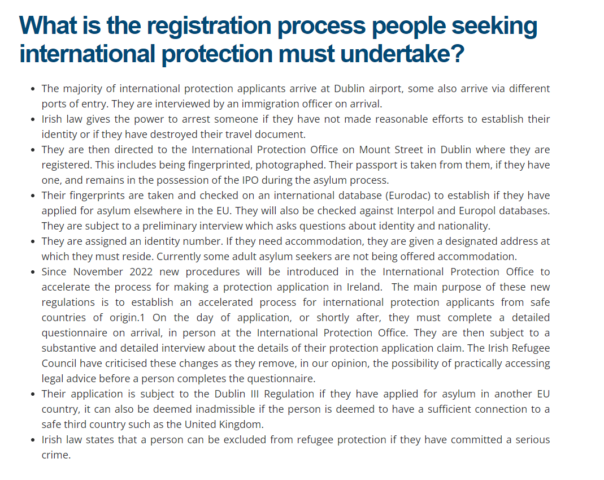The Irish Refugee Council has removed from its website a claim they had repeatedly made that asylum applicants have their fingerprints checked against criminal databases, after being contacted by a Gript investigation which showed the claim was not true according to information released by the Department of Justice.
The question of checks carried out against fingerprints of asylum applicants has become more prevalent after it became known that thousands of those claiming to be asylum seekers had been allowed to enter the country without passports or documentation. Local protesters have described such undocumented arrivals as “unvetted”.
The IRC’s previous explainer on their site claimed that international protection applicants are:
[D]irected to the International Protection Office on Mount Street in Dublin where they are registered. This includes being fingerprinted, photographed. Their passport is taken from them, if they have one, and remains in the possession of the IPO during the asylum process.
Their fingerprints are taken and checked on an international database (Eurodac) to establish if they have applied for asylum elsewhere in the EU. They will also be checked against Interpol and Europol databases. They are subject to a preliminary interview which asks questions about identity and nationality.

However, the Department of Justice has made it clear that fingerprints of international protection applicants are not, in fact, checked against Interpol and Europol databases.
Answers provided by the Department to parliamentary questions asked by Carol Nolan TD show that the International Protection Office does not check fingerprints against any criminal databases.
Gript asked the IRC who had informed them that fingerprints of asylum applicants were checked against Interpol and Europol databases, given that the information, according to the Department of Justice, is not correct. The refugee organisation did not reply.
Gript also pointed to a public statement by CEO of the IRC which had also asserted that checks against criminal databases were made after fingerprints of asylum applicants were taken.
Irish Refugee Council CEO Nick Henderson told the show asylum seekers go through a “very rigorous” identification process in Ireland.
“When somebody applies for asylum in Ireland, they would either do so at the airport or at the International Protection Office in Dublin,” he said.
“There commences a very rigorous process which would begin with a person’s fingerprints being taken, and those fingerprints go on to a European Union-wide database called Eurodac.
“That is for two reasons – one, to check if they’ve claimed asylum elsewhere and two, to check if they are on any criminal databases”.
In fact, Eurodac – as Matt Treacy has pointed out previously on this platform – “is an EU database that stores the fingerprints of international protection applicants or people who have crossed a border illegally.”
The Department of Justice is clear on this matter, confirming in its response to Deputy Nolan that “EURODAC is not a criminal records database”.
The IRC did not respond to the question regarding public statements made by its CEO either – but the organisation has now amended that section of its website, which now reads:
The majority of international protection applicants arrive at Dublin airport, some also arrive via different ports of entry. They are interviewed by an immigration officer on arrival.
Irish law gives the power to arrest someone if they have not made reasonable efforts to establish their identity or if they have destroyed their travel document.
They are then directed to the International Protection Office on Mount Street in Dublin where they are registered. This includes being fingerprinted, photographed.
Their passport is taken from them, if they have one, and remains in the possession of the IPO during the asylum process. They are subject to a preliminary interview which asks questions about identity and nationality.
Gript has asked the IRC why that section of its website was amended and if it was because the information was incorrect. We have also asked if the IRC has or will now seek to address any confusion or misinformation which may have arisen as a result of reliance on that incorrect information.
Similarly, Gript wrote to the Minister for Integration, Roderic O’Gorman, regarding claims he made in the Journal on December 23rd where he said:
“When an International Protection applicant arrives in the country, they’re fingerprinted. Their fingerprints go through two databases. One to see if they’ve been involved with the immigration authorities in any other EU member state and the other to see if they’ve been involved in criminality in any other member state.”
We pointed to the responses from the Department of Justice which showed that the fingerprints of asylum applicants are not checked against a criminal database.
The Minister was asked if he could comment on what appeared to be an incorrect public statement made on the matter. He did not reply.
And in regard to similar remarks made by Taoiseach Leo Varadkar in an interview with Ben Scallan where he said that Ireland was operating “very robust checks” in regard to immigration – which involved, he claimed, taking asylum applicants’ fingerprints and comparing them against databases, including checks against criminal records, we said:
Responses (below) from the Department of Justice to Parliamentary Questions submitted by Carol Nolan TD showed that fingerprints of international protection applicants are not checked against a criminal database.
We asked an Taoiseach if his statements were incorrect and whether he would correct them. No response has been received to that email either.